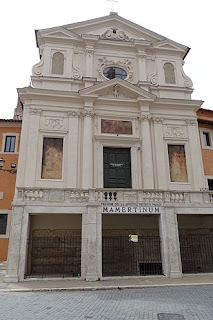Christian significance: threats to the state
It is not known when the prison went out of service permanently, but the site has been used for Christian worship since medieval times, and is currently occupied by two superimposed churches: S. Giuseppe dei Falegnami (upper) and S. Pietro in Carcere (lower). The Cross on the altar in the lower chapel is upside down, since according to tradition Saint Peter was crucified that way. It has been long referenced that St. Peter was imprisoned at the Tullianum, and that the spring in the bottom of the pit came into existence miraculously to enable him to conduct baptisms, but the Catholic Encyclopedia points out that the spring had existed long before, and that there is little first hand account of St. Peter's imprisonment there other than being the only single celled prison available for VIPs deemed threats to the state. Saint Paul's imprisonment is well referenced by his Roman citizenship and decree of execution by Nero.
The origins of the prison's names are uncertain. The traditional derivation of "Tullianum" is from the name of one of the Roman kings Tullus Hostilius or Servius Tullius (the latter is found in Livy, Varro, and also Sallust); there is an alternative theory that it is from the archaic Latin tullius "a jet of water", in reference to the cistern. The name "Mamertine" is medieval in origin, and may be a reference to a nearby temple of Mars.
According to tradition, the prison was constructed around 640–616 BC, by Ancus Marcius. It was originally created as a cistern for a spring in the floor of the second lower level. Prisoners were lowered through an opening into the lower dungeon.





No comments:
Post a Comment